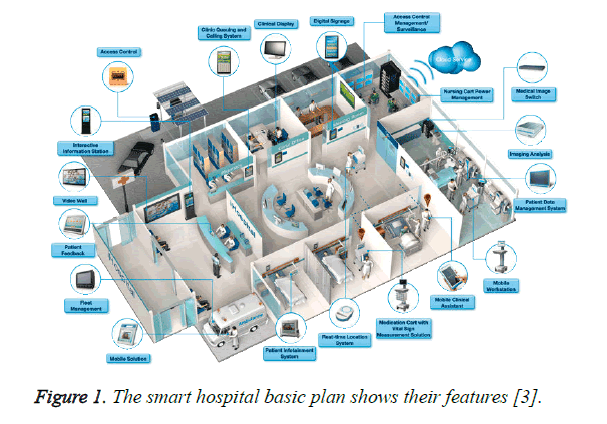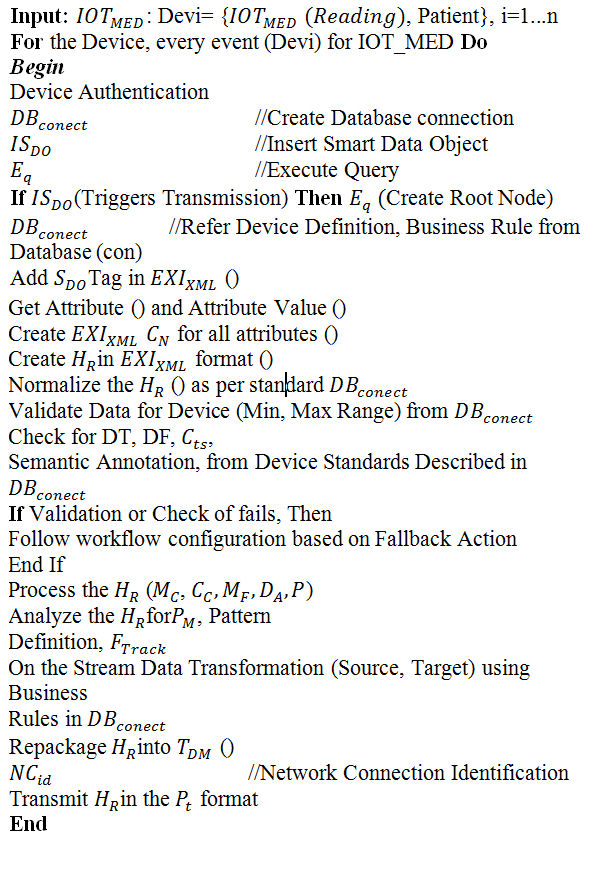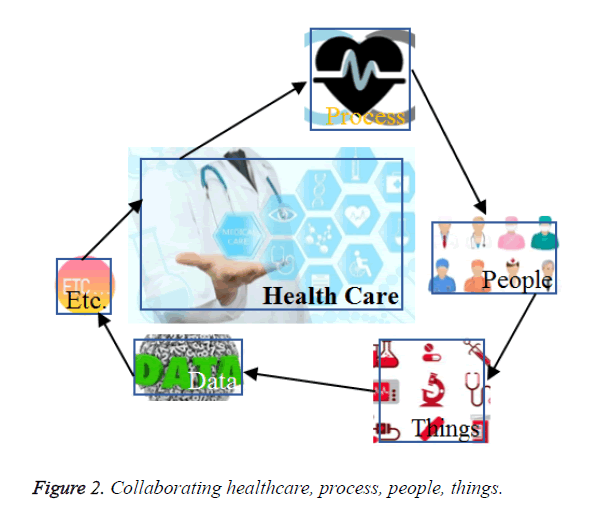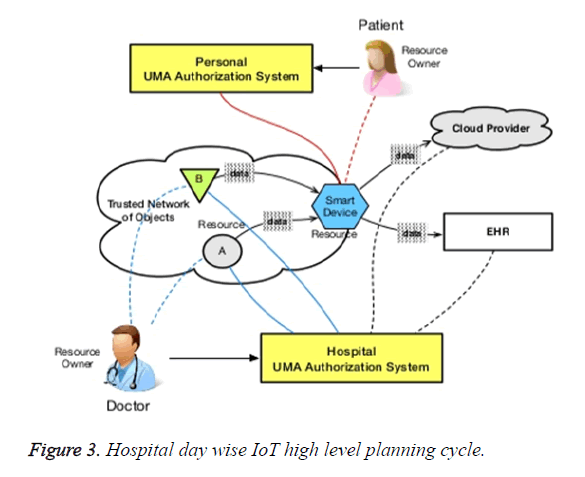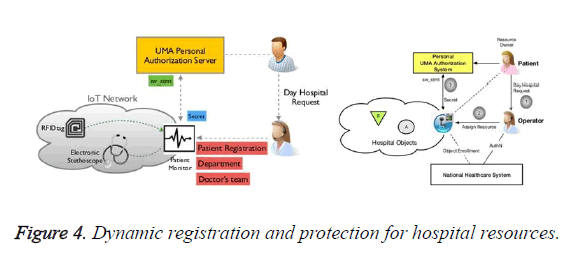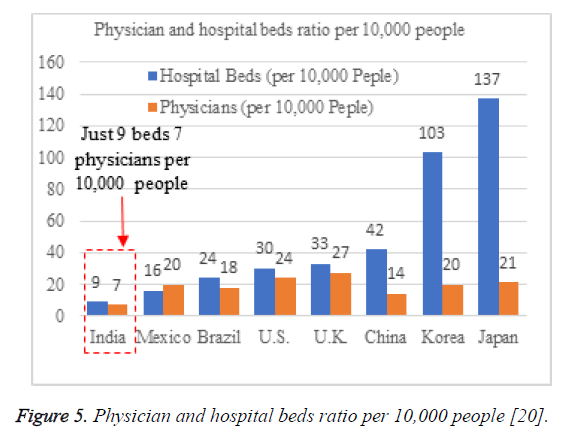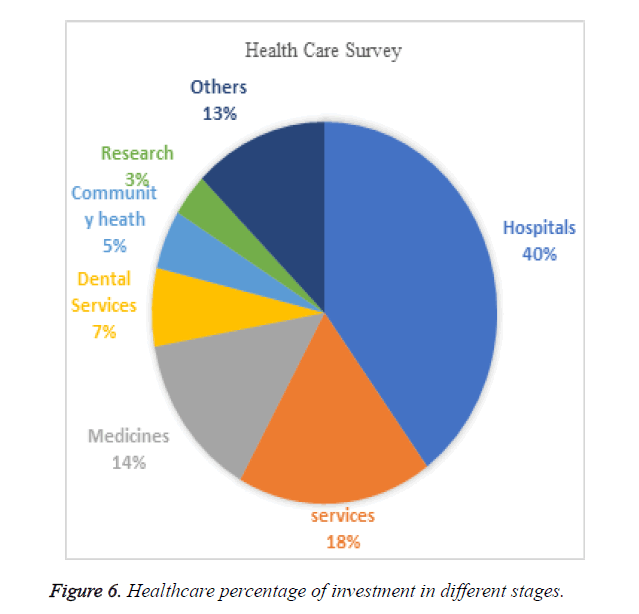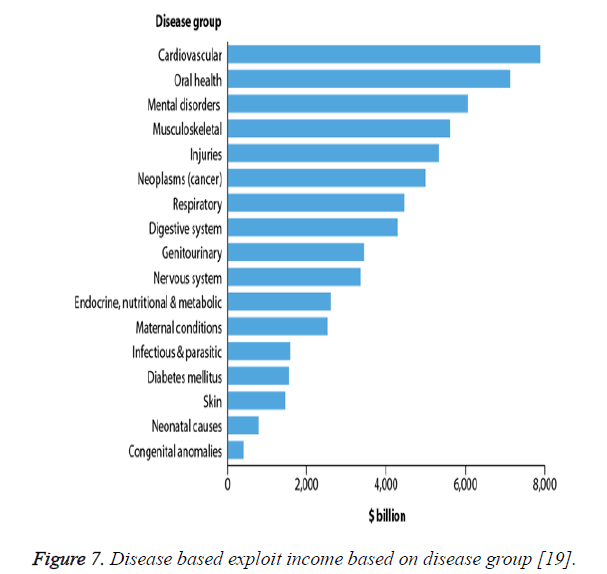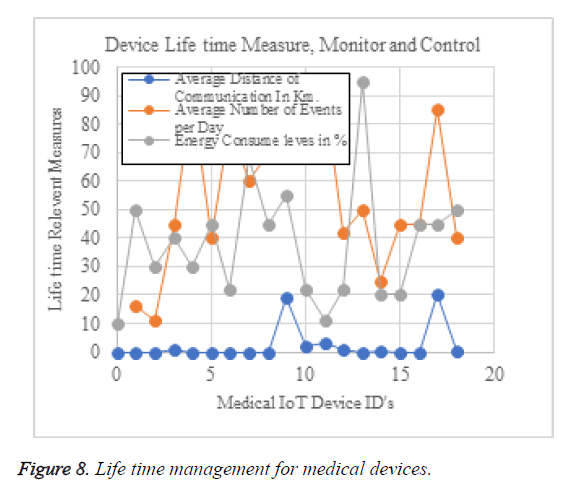Research Article - Biomedical Research (2017) Volume 28, Issue 11
Design and development of low investment smart hospital using internet of things through innovative approaches
Patan Rizwan1, Rajasekhara Babu M1* and Suresh K2
1School of Computer Science and Engineering, VIT University, Vellore, India
2Department of CSE, Annamacharya Institute of Technology and Sciences, Rajampet, Kadapa (Dt), Andhra Pradesh, India
- *Corresponding Author:
- Rajasekhara Babu M
School of Computer Science and Engineering
VIT University, India
Accepted on March 30, 2017
Abstract
Currently smart hospitals are very few as well as very expansive. The cost of these smart hospital set up can be reduced by deploying Internet of Things (IoT). IoT is booming technology in many fields for smart environments. This paper presents an innovative technical support for development of smart hospitals with low investment. Automation in dealing with medical things reduces the human intervention. Patient remote monitoring system monitors the chronic disease patient’s health condition continuously and generates alerts during abnormal situations of patient’s health. A Patient remote monitoring system includes wearable devices which are developed by using Internet of Things. The wearable devices track the patients’ health condition continuously. In addition, the hospital beds equipped with sensors that measure patient’s vital signs that can be converted to deploy as Internet of Medical Things (IoMT) technology. Finally, the proposed model built with very limited capital that provides better service for all kind of peoples.
Keywords
Smart hospitals, Internet of things, Wireless sensors, Real-time device control
Introduction
In a hospital, the Internet of Things (IoT) is made up of Internet Protocol (IP) addressable communications and sensor systems, medical devices, hospital information systems and building systems, such as the electronic medical record. These are all integrated through an enterprise service bus that allows all of these disparate systems to exchange data with each other and with staff, healthcare providers and patients. The Internet of Medical Things (IoMT) is fundamentally changing the delivery of healthcare by information exchange and unifying communications in unparalleled ways, and delivering the right information and resources at the right time to the point of care. The grouping of bidirectional communication between building systems, clinical and business, the operation of smart, semiautonomous sensor networks or devices and the usage of analytics inside a hospital generates endless possibilities for the growth of smart, effective and efficient hospital processes.
Healthcare devices and their setups are become a significantly more complex, a growing challenge presenting for the Information Technology (IT) staff to support them. Rather than thinking solely in terms of bandwidth and device counts, administrations must now reconsider their approach to rethink how best to apply business intelligence to the network and medical device support. The importance of data in delivering efficient, effective health care has long been obvious and has never been greater. The increased focus on value-based care is shifting financial incentives to a model in which providers are compensated based on how their patients fare, rather than by the number of tests [1], number of visits, or performed procedures. This means that patients, providers and everyone in between are additional eager than ever to measure patient outcomes in order to determine what works and who gets paid.
Figure 1 shows that common hospital required facilities. It shows clearly category wise support required to the patients as well as hospital staffs. In this frame work showing their highlight boxes type of support required. This all are clearly categorized in the diagrams form patient entry to leaving from the hospital, what type of facilities to be required for reducing their delay, providing feasibility. To becoming a smart in everywhere in hospital. By our clear study, find an issue that now current smart hospitals [2] are very limited as well as expansive. It is not serve all categories of peoples. Most probably most of the people interacting with hospitals very frequently. In their financial status supports or not they need to bring money somewhere to clear that health issue. In hospitals, manual system is creating headache to the patient’s fast-fall disease is one headache and this system is creating another annoyance. Common people financial status not supports to visit corporate smart hospitals. Although the Internet of Things is transformational in the health care sector, it also presents a number of challenges given that health data is sensitive. There is no doubt that the Internet of Things is transforming the healthcare industry completely by redefining how apps, devices and people connect and interact with each other in delivering healthcare solutions.
Figure 1. The smart hospital basic plan shows their features [3].
Contribution overview
A summarized workflow of the paper as follows:
Categorization necessities of the Smart hospitals, peoples, resources required, service needed.
A Study various block wise requirements for the hospital to be listed.
Existing smart hospitals what type of cost investment policies are there in various fields. In what way to reducing by using latest IoT support.
Proposed an innovative smart hospital framework by using pre-build Internet of Thing kits in various fields of hospital towards creating device automation.
Finally, our approach is to reducing all investment and providing better service for all fields of hospital. Everything connected by internet as well as fully automation it becomes a smart hospital.
Paper arrangement
In this paper discussing first introduction to the innovative creation for the smart hospitals and second related work, third problem statement, fourth Overview of smart hospital framework, fifth Outcomes and discussion and finally sixth conclusion and their references.
Related Work
Hospitals and doctors are very few not meeting the requirements of population. MEMS have opened up grand open admissions for the usage of smart conditions. Particularly in the restorative field, a few sensors to assess diverse sorts of fundamental signs (i.e., heartbeat, body weight and temperature, ECG, and movement) have been created, hence empowering the outline of imaginative administrations ready to significantly enhance residents' social insurance. In this field, among the few research exercises as of now displayed in the writing, those related on the utilization of the UHF RFID innovation are essentially centered around following patients in doctor's facilities and nursing organizations.
In [4], a WSN giving patient confinement, following, and checking administrations inside nursing foundations is introduced. The confinement and following motor depend on the got flag quality marker (RSSI) and molecule channels while biaxial accelerometers are utilized to group the developments of patients.
In [5], authors consolidate together wearable tags and encompassing tags to build up a completely uninvolved RFID framework, named NIGHT-Care, for observing the condition of incapacitated and aged individuals among the night. In particular, NIGHT-Care depends on an encompassing knowledge stage which is proficient to gauge rest parameters, order the human movement, and distinguish irregular occasions that need prompt support.
In [6], RFID Locator, an online application created at the University of Fribourg as a software team through Sun Microsystems, has been proposed to enhance the nature of hospital managements. Latent RFID innovation has been effectively utilized likewise as a part of [7] for gear restriction in healing facilities. As clear from the referred to writing, since RFID labels can work exclusively under the peruse scope district, the utilization of UHF RFID innovation is restricted to patient/gadgets checking and following in very little situations. Another arrangement of related work proposes the utilization of WSN innovation to actualize arrangements ready to meet the particular prerequisites of certain medicinal services applications.
In [8], a remote limitation organizes ready to track the area of patients in indoor situations furthermore to screen their physical status is displayed. An area mindful WSN to track patients utilizing an extending calculation in light of environment and versatility versatile channel (LEVV) is proposed in [9]. An entirely total venture giving patients' checking and following is WSN4QoL [10]. In particular, WSN4QoL depends on a three-level basis engineering, where, at the most reduced level, a Bluetooth-empowered Wireless Body Area Network (WBAN) interfaces sensor hubs to a nearby authority which, thusly, sends estimations reports toward a passage through an IEEE 802.15.4-based ZigBee organize. At long last, the passage performs neighborhood calculation and advances information to the general population IP organize toward the expert parental figures for continuous investigation.
In [11], the 6LoWPAN standard and shrewd portable correspondence procedures are joined to screen the health condition of the patient and give limited successful social insurance managements. More in detail, the proposed arrangement makes utilization of WSN gadgets to gauge Photo Platysma Gram (PPG) flags and convey them to a server through the Internet. An Android gadget is utilized to give a portable social insurance benefit by method for a redid application. Dissimilar to the UHF RFID innovation, the utilization of WSN permits the patients to be observed in a more productive way at the cost of complex calculations required for their exact following. The consolidated utilization of the UHF RFID and WSN advancements, in actuality, could bring extensive advantages, in this manner preparing for the improvement of inventive, smart managements. A first case consolidating UHF RFID and WSN advancements is displayed in [12] where a remote confinement framework for observing kid position in amusement stop is executed by outfitting WSN hubs with UHF-RFID per user capacities. The restriction issue is additionally tended to in [13], where a matrix of UHF RFID labels is utilized to upgrade the limitation exactness of standard RSSI-based WSN calculations.
In [14], author proposed a model that incorporation of WSN hubs and UHF RFID per users for the advancement of a smart distribution center administration framework. To the best of inventors' learning, just few activities have been done to influence the consolidated utilization of UHF RFID and WSN advancements in social insurance situations.
In [15], RFID, WSN, and GSM are abused together to track patients in doctor's facilities and screen their physiological parameters. A brilliant framework utilizing dynamic UHF RFID, WSN, and GSM for real-time supervision of patients is exhibited and examined in [16]. A fascinating endeavour that intends to consolidate and incorporate, at physical layer, heterogeneous environment advancements, receives the RESTful worldview and PN, and oversees ready occasions in a keen doctor's facility is accounted for in our earlier work [17]. More inside and out, it depicts a keen framework in light of UHF RFID and ZigBee-based WSN responses for the programmed observing and following of patients inside health centers. It can gather, continuously, both patients' physiological parameters and natural conditions, and, if there should be an occurrence of crisis, to expeditiously advise the nursing staff through a product application particularly intended for advanced mobile phones and tablets. With a specific end goal to deliver the common objective to plan a consistent system effortlessly deployable in an assortment of situations, the utilization of a WSN in view of the Constrained Application Protocol (CoAP) for interfacing and checking medicinal sensors is pushed [18]. The CoAP selection in medicinal services situations speaks to a vital viewpoint since some CoAP worked in elements, for example, quality perception (specific helpful for on-going observing of patients' imperative signs) and revelation, empower a dynamic domain where the accessible assets are consequently found and arranged.
Smart Hospital Proposed Framework
In this section, discussing that stage by stage to the hospitals is changing as smart. Technology required in each phase of the hospital is clearly described. First, describe the overview of the system Hospital system. Second, technologies are to be added in different phases. In algorithm 1, coated those basic complete points of the medical device integration. IoT Medical devices are equal to IoT Medical record, Patient Transmit H_R EHC Record in the P_t Protocol transmission format. In this approach is in view of prototype framework for the smart hospital requirements and their specification categorized in this work.
Overview Smart Hospital Frame Work
In the Healthcare process before going to meet the doctor so many formalities are required. Traditional or manual way of completing these formalities is very difficult process. Patient gets depression and tension it causes increasing patient Blood Pressure (Bp) other diseases. It is required to improve digital support in all the aspect to the hospital everything change to smart. Figure 2 shows that interactive work follows for patient and doctor in between things.
Hospital day based activity architecture for the IoT High level architecture. It uses to what type of process involve to patient and doctor. In middle patient and their personal User Maintenance Application (UMA) authentication system smart device as a resource. Doctor to the hospital UMA authentication system is maintained by the Electronic Health Records (EHR). The all record information should be connected by the Cloud provider in between observing trusted network of object are there it shows in Figure 3 as clear view of the IoT high level architecture use case flow.
Patient resource registration by using the digital tools using the dynamic registration. The respected flow is going to the patient to the operator day hospital request and national healthcare system. Assigning resources hospital objects weather availability of resources object enrolment. In Figure 4 resource reservation and protection. The whole approach is processing with dynamically by using the UMA personal authentication server and system. Each process involving patient registration, department and doctor team for patient monitoring system. IoT network involves RFID tags, Electronic Stethoscope.
Once patient enters into the hospital before meeting doctor some of basic tests need to be done. There are no standards for electronic health records and they do not interconnect. You can’t get data from one hospital to the next. The future is to connect all sensors, wearable’s, things, in the home, etc., and have everything diffusing securely and safely into cloud so doctors working in smart hospitals can go back to being doctor and not data entry clerks.”
Internet of things module
IoT empower Smart Hospital technology future is applying to changing our lives. There is no doubt to that. Whereas some of the features it is more visible with the fast growth of no. of smart medical devices, wide use and accessibility of smart mobiles and continuous demand for better health care the need for better solutions is increasing and better interconnectivity technology. Some technology will have to connect all of new and existing type of sensors, medical equipment, and wearable’s together. Also, less people need to appointment hospital, they have to track state of their health using mobile or tablet IoT for health connectivity IoT will not only help us to connect existing medical devices and technologies together, it will also enable remote monitoring, remote control and even make a new bionetworksmart hospitals. It has increased rapid produces in last decade, as for medical application it is only starting to boom. IoT is extremely scalable technology. The industry is expected to reach $117 billion dollars by 2020 convoyed by the rapid growth of no. of medical smart devices, wide use of better internet connection and mobile apps. When evolving innovative health wearable device or app selecting a technology or making tradition planning for communication is important part of design process. IoT middleware as supports to link all categories of medical devices be it smart bed, heart rate sensor, patient room ventilation systems.
Secure IoT assistances to transfer critical medical data, which eliminates essential of treatment data from one hand to another. Another benefit of IoT is data agnostic, currently still having medical devices are very old, and the fast-rising amount of innovative technology. IoT helps as enabler for real-time organization of healthcare. It permits for monitoring patient conditions remotely, decreases amount of essential medical kits, and allows patients and doctors to use their time more efficiently.
Smart building systems, such as different sensor equipment, temperature control and other electronic equipment classically found in the hospital to Smart Hospital system through IoT. This will allow dissimilar end of the systems to information exchange, patient location, keep track of doctor and remotely monitor state of health monitor. Connectivity to large computational groups permits to study of all kinds of medical information.
Utilizing recovered information, smart health center facility frameworks will have the capacity to screen and advise hospital and patient about condition of their health and what solution is important right now. Not just it will treat distinctive ailments it will likewise have the capacity to help take precaution measures, make customized health profiles and take work of requesting pharmaceutical or pills without anyone else.
Forthcoming of medical care is allowed in hospitals to be removing unnecessary managerial tasks, quality of service improving and patient centered. Patients and medical staff will expansion more flexibility. Being data concerned with all the data being in digital form, Smart Hospital subsystems will be interoperable as all devices could talk teach other switching various types of data. As systems are no longer directly controlled by people we can eliminate some errors of human factor.
Big data analytics module
It receives the sensors information with sensor Id. Compute all the information performing analytics operations. Various factors are considering for calculating individual sensor strength and add each other sensor entry and leaving vehicle details road capacity, etc. factors are considered compute analysed report are to be produced it make ready through access by using internet either mobile APP or internet browser. Here apply various forms are approaches [19] are connected with latest real-time streaming data processing mechanisms are used.
User interaction modules
In this module consists of the latest analytics and decision tools are providing for travellers. Capacity of road number of vehicles are there status everything shown accessing internet. Multiple way’s user wants to access the information example mobile APP, internet browser throw enabling GPS on Device, etc. In user point of view very faster interaction and fast data processing are to be done by using background as big data stream analytics. For better and faster real-time data stream computing as well as analytics on top of that we apply.
Practical Approach and Their Outcomes
In practical setup, we are taken Intel IoT kit and health related sensors installed in multiple places. BP meter, digital dharma meter, electronic stethoscope, etc. in all phases of medical field are change to digital devices. These sensors send its data periodically and also on demand. The sensor information further can be used appropriate action through rules computation. Henceforth, the system addresses 4 levels of smartness, Connected one centralized Network based control system to control things. Cloud services and background big data analytics. With all combined hospital package like device kits need to be provided for all the manual hospitals.
Smart hospitals multiple things to be consider for our outcomes. In hospitals and their resources in India. Figure 5 shows the hospital beds per 10,000 peoples and Physicians per 10,000 peoples. India is very poor just 9 beds and 7 physicians per 10,000 peoples. While comparing to other countries, India ratio is very poor. There are wide crevices between the provincial and urban populace in its medicinal services framework. A stunning 70 for every penny of the populace still lives in country regions and has no or restricted access to healing centers and facilities. Around 80 for every penny of pros live in urban ranges. Change in medicinal services foundation and offices and simple entry to them is the main way India can battle against diseases. For that to happen, government spending on medicinal services must go up. In any case, the situation, as they are currently, is not extremely promising.
Figure 5. Physician and hospital beds ratio per 10,000 people [20].
The NDA Government planned to realize a 'total change' of the Healthcare area and even fragmented away at the outline of the world's biggest general medical coverage program, central roused by US President Barack Obama's fantastic protection for-all venture which is prevalently known as 'Obamacare'. The Government now needs [21] to follow up on its arrangements. The Union Budget 2016 must apportion more cash to the human services division. The area is in critical need of assets to enhance their framework and aptitude sets and to build limit. There are spillages of apportioned supports at all levels. It is imperative to connection activities like Digital India to get more straightforwardness in the designation of assets and its consumption by Government Hospitals and Medical Officers. Figure 6 shows the percentages of the Healthcare related investment percentage in different stages.
Figure 7 shows the disease wise cost spending in dollars, another approach to take a gander at health spending is to consider how much cash is spent on various conditions. Around 66% of aggregate consistent health spending can be assigned to disease groupings. Of the general gatherings appeared, cardiovascular maladies represented the best burning through ($7.9 billion or 11%) trailed by oral health ($7.1 billion or 10%) and mental clutters ($6.1 billion or 8%). Mind gave to patients admitted to a doctor's facility made up the main part of spending for some sickness gatherings, (for example, innate inconsistencies (birth imperfections) and growths) [22]. For other sickness gatherings, (for example, oral health), a more noteworthy extent of spending went towards administrations, projects and merchandise outside the clinic setting.
Figure 7. Disease based exploit income based on disease group [19].
The challenge with standalone devices is they must be built with secure and safe ways to get information into the cloud, to providers and doctors to understand if those devices are functioning properly and giving the correct dose of medication.
In Figure 8 shows the IoT enabled medical device types and their life time management each device. it is having three parameters, one is the Energy level in percentages, second one is an average number of events per day, and third is average distance of communication with other devices. Lifetime relevant measures with their medical devices id’s. Managing the devices are very high impact in overall cast system.
Conclusion
This paper concentrates on the general approach and technique for the IOT empowered self-governing smart hospitals facility managing framework with the associated Device choice, data signifying, interoperability, data mapping and data change, data approval and data exclusion, prepare stream arrangement for occasion driven work processes, engineering and foundation choice subtle elements. The quality procedures recommended a booked routine or technique to check the legality of the device working standards. The lab management, in/out patient management, operational care, outpatient treatment, room label, medical check-ups, staff-organization, innovative avenues inter departmental operations are a portion of the arranged future utilize cases to get executed as a major aspect of the framework. The data produced out of the on-going devices result in the massive volume of data which needs the cloud and big data study phase. Proposed smart hospital development with low investments organized framework in all areas of country. Smart features to be deployed in all phases of the hospitals. The hospitals are facilitating these features in their hospitals it is reducing the waiting time, improve quality and care delivery of the patients.
References
- Rajasekhara Babu M, Alok AJB. Automation testing software that aid in efficiency increase of regression process. Rec Patents Comp Sci 2013; 6: 107-114.
- Smart Hospital Vision Available online URL: http://mackenziehealth.ca/ioht.php?id=598 (Last accessed 10 Dec, 2016)
- Smart Hospitals Total Solutions for a new Era Available online URL: http://www2.advantech.com/EDM/D3CED416-A219-536-8804 5D58070095B/2015_HIMSSinv2/index1.html (Last accessed 10 Dec. 2016)
- Redondi MC, Borsani L, Cesana M, Tagliasacchi M. An integrated system based on wireless sensor networks for patient monitoring, localization, and tracking. Ad Hoc Netw 2013; 11: 39-53.
- Occhiuzzi CV, Amendola S, Manzari S, Marrocco G. IGHT-care: A passive RFID system for remote monitoring and control of overnight living environment. Procedia Comput Sci 2014; 32: 190-197.
- Fuhrer P, Guinard D. Building a smart hospital using RFID technologies. Proc 1st Eur Conf eHealth (ECEH06) 2006; 91: 131-142.
- Shirehjini AN, Yassine A, Shirmohammadi S. Equipment location in hospitals using RFID-based positioning system. IEEE Trans Inf Technol Biomed 2012; 16: 1058-1069.
- Dsouza M, Wark T, Ros M. Wireless localization network for patient tracking. Proc Int Conf Intell Sensors Sensor Netw Inf Process 2008; 79-84.
- Chandra-Sekaran K, Dheenathayalan P, Weisser P, Kunze C, Stork W. Empirical analysis and ranging using environment and mobility adaptive RSSI filter for patient localization during disaster management. Proc Int Conf Netw Services (ICNS09) 2009; 276-281.
- Tennina S. WSN4QoL: A WSN-oriented healthcare system architecture. Int J Distrib Sensor Netw 2014; 1-16.
- Jung SJ, Myllyla R, Chung WY. Wireless machine-to-machine healthcare solution using android mobile devices in global networks. IEEE Sensors J 2013; 13: 1419-1424.
- Chen. Design of a child localization system on RFID and wireless sensor networks. J Sensors 2010; 1-8.
- Xiong Z, Sottile F, Spirito M, Garello R. Hybrid indoor positioning approaches based on WSN and RFID. Proc IFIP Int Conf New Technol Mobility Security 2011; 1-5.
- Xiaoguang Z, Wei L. The research of network architecture in warehouse management system based on RFID and WSN integration. Proc IEEE Int Conf Autom Logist 2008; 2556-2560.
- Renuka N, Nan NC, Ismail W. Embedded RFID tracking system for hospital application using WSN platform. Proc IEEE RFID Technol Appl (RFID-TA) Conf 2013; 1-5.
- Rajesh SM. Integration of active RFID and WSN for real time low cost data monitoring of patients in hospitals. Proc Int Conf Control Autom Robot Embedded Syst (CARE) 2013; 1-6.
- Catarinucci L. Integration of UHF RFID and WSN technologies in healthcare systems. Proc IEEE RFID Technol Appl (RFID-TA) Conf 2014; 289-294.
- Khattak HA, Ruta M, Di Sciascio E. CoAP-based healthcare sensor networks: A survey. Proc 11th Int Bhurban Conf Appl Sci Technol (IBCAST) 2014; 499-503.
- WHO India statistics Available online URL: http://www.who.int/gho/countries/ind.pdf?ua=1 (Last Accessed 12 Dec. 2016).
- Henry H. MCVEY India: Unlocking the demographic dividend 2012.
- Sanchez D, Monica T, Jesus F. Activity recognition for the smart hospital. IEEE Intel Syst 2008; 23: 50-57.
- Rajasekhara Babu M, Venkata Krishna P, Khalid. A framework for power estimation and reduction in multi-core architectures using basic block approach. Int J Commun Networks Distrib Syst Inderscience Enterp Ltd 2013; 10: 40-51.
